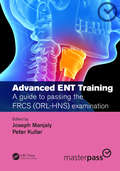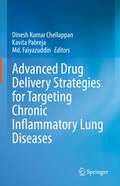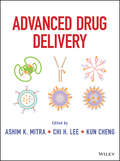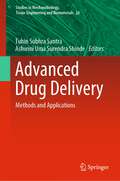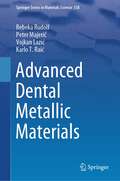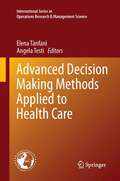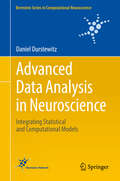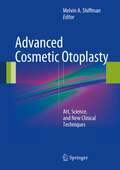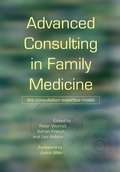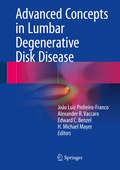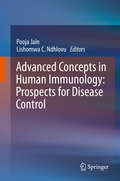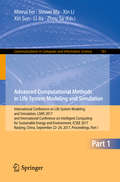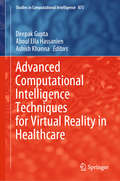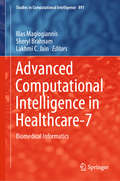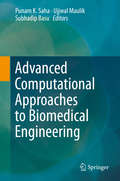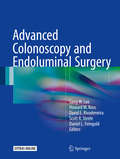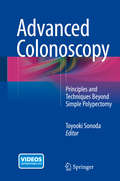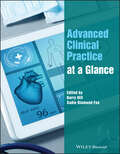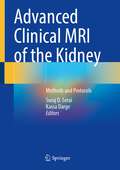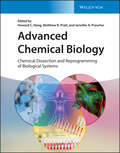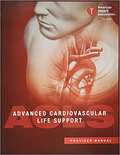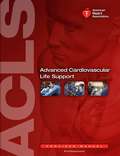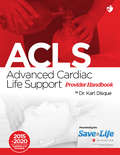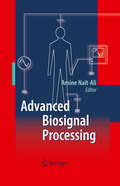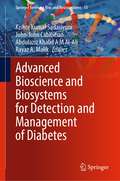- Table View
- List View
Advanced ENT training: A guide to passing the FRCS (ORL-HNS) examination
by Joseph Manjaly Peter KullarThe syllabus for the FRCS (ORL-HNS) is vast and sound preparation for the exams has traditionally involved assimilatiing knowledge from a wide range of sources. This book provides a focussed guide for exam candidates. More than a question and answer book, this book is a coaching manual. Each section features a combination of model answers, pearls of wisdom, checklists and pointers for further reading. Detailed advice is provided for both Part 1 and Part 2 of the examnation. Viva topics that have featured in the exam in recent years have been included. and have then been supplemented by invaluable editorial contributions from leaders in each of the subspecialties. Trainees frequently comment that exam preparation is an enlightening process and the knowledge gained would have served them well during their time as an ENT registrar or Otorhinolaryngology resident.This book will also serve as a valuable learning tool for trainees as early as ST3 and facilitate their development of effective and safe clinical practice.
Advanced Drug Delivery Strategies for Targeting Chronic Inflammatory Lung Diseases
by Dinesh Kumar Chellappan Kavita Pabreja Md. FaiyazuddinThis book describes the growing clinical and healthcare relevance of nano-therapeutics in treating respiratory diseases. It begins with a brief introduction on the different types of nanoparticles in respiratory disease conditions. It further discusses the current trends in understanding the disease pathology using different in vitro and in vivo models, which are important towards the onsite clinical applications and development of new therapeutics. The book includes exciting topics such as formulation of these nanoparticles, targeting various organelles etc. It also describes the future prospects and challenges in the field. Different chapters are written by researchers actively working in the area of pulmonary diseases. This book is designed to address the requirements of both beginners and specialized scientists involved in pulmonary research. The contents include basic concepts followed by advanced state-of-art monitoring and treatment of diseases. The book is meant for researchers and industry experts in nanotechnology, pharmaceutical sciences and drug design.
Advanced Drug Delivery
by Ashim Mitra Chi H. Lee Kun ChengProvides both fundamentals and new and emerging applications Advanced Drug Delivery brings readers fully up to date with the state of the science, presenting the basics, formulation strategies, and therapeutic applications of advanced drug delivery. The book demonstrates how core concepts of pharmaceutical sciences, chemistry, and molecular biology can be combined and applied in order to spark novel ideas to design and develop advanced drug delivery systems for the treatment of a broad range of human diseases. Advanced Drug Delivery features contributions from an international team of pharmaceutical scientists. Chapters reflect a thorough review and analysis of the literature as well as the authors' firsthand experience developing drug delivery systems. The book is divided into four parts: Part I, Introduction and Basics of Advanced Drug Delivery, explores physiological barriers, stability, transporters, and biomaterials in drug delivery Part II, Strategies for Advanced Drug Delivery, offers tested and proven strategies for advanced delivery of both small molecules and macromolecules Part III, Translational Research of Advanced Drug Delivery, focuses on regulatory considerations and translational applications of advanced drug delivery systems for the treatment of cardiovascular diseases, cancer, sexually transmitted diseases, ophthalmic diseases, and brain diseases Part IV, Future Applications of Advanced Drug Delivery in Emerging Research Areas, examines stem cell research, cell-based therapeutics, tissue engineering, and molecular imaging Each chapter provides objectives and assessment questions to help readers grasp key concepts and assess their knowledge as they progress through the book. Advanced Drug Delivery is recommended for graduates and upper-level undergraduates in the pharmaceutical sciences who need a solid foundation in the basics. It is also recommended for pharmaceutical professionals who want to take advantage of new and emerging applications in advanced drug delivery systems.
Advanced Drug Delivery: Methods and Applications (Studies in Mechanobiology, Tissue Engineering and Biomaterials #26)
by Tuhin Subhra Santra Ashwini Uma Surendra ShindeThis book provides an overview of various drug delivery systems at the cellular level including biological, chemical methods, and most importantly physical methods such as photoporation, electroporation, mechanoporation, and device-based techniques (e.g., microfluidics), as well as organism-level techniques including nanomaterials, biomaterials, and transdermal. Drug delivery (DD) can be defined as the method and route by which an active pharmaceutical ingredient (API) is administered to promote its desired pharmacological effect and/or convenience and/or to reduce adverse effects. Drug delivery systems are developed to maximize drug efficacy and minimize side effects. As drug delivery technologies improve, the drug becomes safer and more comfortable for patients to use. During the last seven decades, extraordinary progress has been made in drug delivery technologies, such as systems for long-term delivery for months and years, localized delivery, and targeted delivery. The advances, however, will face the next phase considering the future technologies that we need to overcome many physicochemical barriers for new formulation development and biological unknowns for treating various diseases. Thus, various technologies are built at a single-cell level as well as an organism level. This book is useful at the university level for graduate courses or research studies and biotechnology-based companies with research and development on cell-based analysis, diagnosis, or drug screening. This book is also very useful for researchers in drug delivery technologies, which came in frontier research for the past decade.
Advanced Dental Metallic Materials (Springer Series in Materials Science #338)
by Rebeka Rudolf Peter Majerič Vojkan Lazić Karlo T. RaićThis book delivers a broad and concise look at advanced metallic materials used for dental applications. Due to their excellent mechanical and biological properties, the use of metallic materials in dentistry has continued since time immemorial. In that sense, this book aims to bring the readers closer to the specific purpose of dental metallic materials meeting specific criteria and materials properties such as biocompatibility, non-toxicity, resistance to corrosion, long-term durability, appropriate strength and toughness, as well as corresponding values of modulus of elasticity. Following a comprehensive introduction to the field, the book discusses topical issues such as the long-term stability of dental titanium implants, processing of cobalt-chrome dental alloys, emerging gold dental alloys, and novel nanofoils used for dental joining. Featuring numerous illustrative examples of experimental outcomes, this book is an ideal resource for materials scientists and metallurgists working on advanced alloys for dental applications.
Advanced Decision Making Methods Applied to Health Care (International Series in Operations Research & Management Science #173)
by Angela Testi Elena TanfaniThe most difficult part of making decisions in the health care field on all levels (national, regional, institutional, patient) is linked to the very complexity of the system itself, to the intrinsic uncertainty involved and its dynamic nature. This requires not only the ability to analyze and interpret a large amount of information but also arrange it so that it becomes a cognitive base for appropriate decision-making. Moreover, decisions in the health care field are subjected to many challenges and constraints: fast change and uncertain outcomes, aging population, increasing citizen expectations, equity considerations and limited resources. Operations research, statistical and economic-related quantitative methods supply these decisions making tools and methodology. The contributed book presents a collection of applications to concrete situations detailing the problem area, the methodology employed, the implementation and results. Each topic addressed in the book will be structured in such a way that an interdisciplinary and wide audience will be able to use the materials presented. As an example the book chapters will address health policies issues, planning health services, epidemiology and disease modelling, home-care modelling, logistics in health care, capacity planning, quality and appropriateness.
Advanced Data Analysis in Neuroscience: Integrating Statistical and Computational Models (Bernstein Series in Computational Neuroscience)
by Daniel DurstewitzThis book is intended for use in advanced graduate courses in statistics / machine learning, as well as for all experimental neuroscientists seeking to understand statistical methods at a deeper level, and theoretical neuroscientists with a limited background in statistics. It reviews almost all areas of applied statistics, from basic statistical estimation and test theory, linear and nonlinear approaches for regression and classification, to model selection and methods for dimensionality reduction, density estimation and unsupervised clustering. Its focus, however, is linear and nonlinear time series analysis from a dynamical systems perspective, based on which it aims to convey an understanding also of the dynamical mechanisms that could have generated observed time series. Further, it integrates computational modeling of behavioral and neural dynamics with statistical estimation and hypothesis testing. This way computational models in neuroscience are not only explanat ory frameworks, but become powerful, quantitative data-analytical tools in themselves that enable researchers to look beyond the data surface and unravel underlying mechanisms. Interactive examples of most methods are provided through a package of MatLab routines, encouraging a playful approach to the subject, and providing readers with a better feel for the practical aspects of the methods covered. "Computational neuroscience is essential for integrating and providing a basis for understanding the myriads of remarkable laboratory data on nervous system functions. Daniel Durstewitz has excellently covered the breadth of computational neuroscience from statistical interpretations of data to biophysically based modeling of the neurobiological sources of those data. His presentation is clear, pedagogically sound, and readily useable by experts and beginners alike. It is a pleasure to recommend this very well crafted discussion to experimental neuroscientists as well as mathematically well versed Physicists. The book acts as a window to the issues, to the questions, and to the tools for finding the answers to interesting inquiries about brains and how they function. " Henry D. I. Abarbanel Physics and Scripps Institution of Oceanography, University of California, San Diego "This book delivers a clear and thorough introduction to sophisticated analysis approaches useful in computational neuroscience. The models described and the examples provided will help readers develop critical intuitions into what the methods reveal about data. The overall approach of the book reflects the extensive experience Prof. Durstewitz has developed as a leading practitioner of computational neuroscience. " Bruno B. Averbeck
Advanced Cosmetic Otoplasty: Art, Science, and New Clinical Techniques
by Melvin A. ShiffmanIn this book, international experts present up-to-date techniques of otoplasty in which they have extensive personal experience. Both new and modified procedures are described with the aid of a wealth of high-quality illustrations. In addition to these detailed descriptions, ear embryology and anatomy, psychological issues, postoperative care, possible risks and complications, and outcomes are extensively covered in order to provide the reader with a state of the art account of all aspects of cosmetic otoplasty. Throughout, the contributors are inventive and eloquent in guiding the reader to a better understanding that optimal results of otoplasty will be achieved only with a more refined approach than the routine use of simplified techniques. This book will be of value to both students (residents and fellows) and experienced cosmetic, plastic, maxillofacial, and general surgeons.
Advanced Consulting in Family Medicine: The Consultation Expertise Model (Radcliffe Ser.)
by Peter Worrall Adrian French Les AshtonWhat distinguishes the consulting of experienced family doctors from their newly qualified colleagues? The question is often frustratingly hard answer clearly or objectively: unlike many professions, family doctors face a dearth of clear expectations of what constitutes advanced practice, a lack of defined standards against which to evaluate it, and an absence of expertise-related professional training in which to develop it post-certification. The model of consultation excellence outlined in this book illustrates in practical terms how advanced consulting can be nurtured. It avoids tantalising value judgement such as 'excellence'. Instead, it describes behaviours in terms that can be observed day to day, providing a detailed picture of what constitutes advanced consulting behaviour, how family doctors can be helped to acquire these higher levels of expertise, and how changes in behaviour can be identified and evaluated. "Advanced Consulting in Family Medicine" is written in handbook form for easy access and use, and provides a vital vision of higher order family doctor consulting.
Advanced Concepts in Lumbar Degenerative Disk Disease
by H. Michael Mayer João Luiz Pinheiro-Franco Alexander R. Vaccaro Edward C. BenzelIn this book, leading international specialists in the field join forces to discuss topics, issues and approaches that are of key importance in the optimal treatment of lumbar degenerative disk disease. The coverage is wide ranging, from current understanding of physiopathology and genetics and modern imaging techniques through to the diverse minimally invasive, non-fusion, and fusion surgical techniques. Detailed attention is drawn to the most important aspects to be considered when approaching the patient and making treatment decisions. The role of conservative management is appraised, and surgical techniques and their indications are carefully described. In the concluding section, some of the top specialists from across the world reflect on the lessons that they have learned during lifetimes in spinal surgery. Advanced Concepts in Lumbar Degenerative Disk Disease will be an instructive and fascinating source of information for all spine surgeons and other spine care providers.
Advanced Concepts in Human Immunology: Prospects For Disease Control
by Pooja Jain Lishomwa C. NdhlovuThis book highlights information derived primarily from clinical samples, with particular reference to theoretical and scientific aspects of the human immune system. This text will focus on topics that range from host-pathogen interactions in infectious disease to host immune response in cancer, allergic diseases, neuroinflammatory diseases, and autoimmune disorders. The reader will also have a well-rounded understanding of the behavior of the immune system with particular emphasis on the role of immunoproteomics in immunotherapy, neuroprotective immunity for neurodegenerative and neuroinfectious disease, leukemia-associated dendritic cell induction of adaptive immunity dysregulation, and the role of immune checkpoint inhibitors in cancer, infection, as well as neuroinflammation. Taken together, the contents of this book are intended for both clinicians and researchers in academia and industry.
Advanced Computational Methods in Life System Modeling and Simulation: International Conference on Life System Modeling and Simulation, LSMS 2017 and International Conference on Intelligent Computing for Sustainable Energy and Environment, ICSEE 2017, Nanjing, China, September 22-24, 2017, Proceedings, Part I (Communications in Computer and Information Science #761)
by Xin Li Xin Sun Zhou Su Minrui Fei Shiwei Ma Li JiaThe three-volume set CCIS 761, CCIS 762, and CCIS 763 constitutes the thoroughly refereed proceedings of the International Conference on Life System Modeling and Simulation, LSMS 2017, and of the International Conference on Intelligent Computing for Sustainable Energy and Environment, ICSEE 2017, held in Nanjing, China, in September 2017. The 208 revised full papers presented were carefully reviewed and selected from over 625 submissions. The papers of this volume are organized in topical sections on: Biomedical Signal Processing; Computational Methods in Organism Modeling; Medical Apparatus and Clinical Applications; Bionics Control Methods, Algorithms and Apparatus; Modeling and Simulation of Life Systems; Data Driven Analysis; Image and Video Processing; Advanced Fuzzy and Neural Network Theory and Algorithms; Advanced Evolutionary Methods and Applications; Advanced Machine Learning Methods and Applications; Intelligent Modeling, Monitoring, and Control of Complex Nonlinear Systems; Advanced Methods for Networked Systems; Control and Analysis of Transportation Systems; Advanced Sliding Mode Control and Applications; Advanced Analysis of New Materials and Devices; Computational Intelligence in Utilization of Clean and Renewable Energy Resources; Intelligent Methods for Energy Saving and Pollution Reduction; Intelligent Methods in Developing Electric Vehicles, Engines and Equipment; Intelligent Computing and Control in Power Systems; Modeling, Simulation and Control in Smart Grid and Microgrid; Optimization Methods; Computational Methods for Sustainable Environment.
Advanced Computational Intelligence Techniques for Virtual Reality in Healthcare (Studies in Computational Intelligence #875)
by Aboul Ella Hassanien Deepak Gupta Ashish KhannaThis book addresses the difficult task of integrating computational techniques with virtual reality and healthcare. It discusses the use of virtual reality in various areas, such as healthcare, cognitive and behavioural training, understanding mathematical graphs, human–computer interaction, fluid dynamics in healthcare industries, accurate real-time simulation, and healthcare diagnostics.Presenting the computational techniques for virtual reality in healthcare, it is a valuable reference resource for professionals at educational institutes as well as researchers, scientists, engineers and practitioners in industry.
Advanced Computational Intelligence in Healthcare-7: Biomedical Informatics (Studies in Computational Intelligence #891)
by Lakhmi C. Jain Sheryl Brahnam Ilias MaglogiannisThis book presents state-of-the-art works and systematic reviews in the emerging field of computational intelligence (CI) in electronic health care. The respective chapters present surveys and practical examples of artificial intelligence applications in the areas of Human-Machine Interface (HMI) and affective computing, machine learning, big health data and visualization analytics, computer vision and medical image analysis. The book also addresses new and emerging topics in CI for health care such as the utilization of Social Media (SM) and the introduction of new intelligent paradigms in the security and privacy domains, which are critical for the health sector. The chapters, while of course not exhaustively addressing all the possible aspects of the aforementioned areas, are indicative of the dynamic nature of interdisciplinary research being pursued. Accordingly, the book is intended not only for researchers in the respective fields, but also for medical and administrative personnel working in the health sector, as well as managers and stakeholders responsible for making strategic decisions and defining public health policies.
Advanced Computational Approaches to Biomedical Engineering
by Ujjwal Maulik Punam K. Saha Subhadip BasuThere has been rapid growth in biomedical engineering in recent decades, given advancements in medical imaging and physiological modelling and sensing systems, coupled with immense growth in computational and network technology, analytic approaches, visualization and virtual-reality, man-machine interaction and automation. Biomedical engineering involves applying engineering principles to the medical and biological sciences and it comprises several topics including biomedicine, medical imaging, physiological modelling and sensing, instrumentation, real-time systems, automation and control, signal processing, image reconstruction, processing and analysis, pattern recognition, and biomechanics. It holds great promise for the diagnosis and treatment of complex medical conditions, in particular, as we can now target direct clinical applications, research and development in biomedical engineering is helping us to develop innovative implants and prosthetics, create new medical imaging technologies and improve tools and techniques for the detection, prevention and treatment of diseases. The contributing authors in this edited book present representative surveys of advances in their respective fields, focusing in particular on techniques for the analysis of complex biomedical data. The book will be a useful reference for graduate students, researchers and industrial practitioners in computer science, biomedical engineering, and computational and molecular biology.
Advanced Colonoscopy and Endoluminal Surgery
by David E. Rivadeneira Scott R. Steele Sang W. Lee Howard M. Ross Daniel L. FeingoldEach chapter of this new book on advanced lower GI endoscopy and endoluminal surgery focuses on the thought process and step-wise technical approach to the condition and procedure listed. By using this unique method, practitioners ranging from surgeons-in-training, gastroenterologists-in-training and those early in their career to senior colorectal specialists and gastroenterologist who want to incorporate or improve their advanced endoscopic skills will be able utilize techniques and learn from this gathering of experts. The guiding principle of this work is to create a resource for surgeons and gastroenterologists that extends beyond the currently available texts, and that surgeons and gastroenterologists can turn to when wanting to "brush up" on techniques, find a useful "tip or trick" for a complex patient, or simply learn a reproducible methods for advanced endoscopic procedures. This unique book highlights current knowledge, demonstrates standards of medical care, and provides clear step-by-step reproducible techniques even for the most advanced procedures. Beyond the simple application of technical knowledge the book addresses the deeper questions about the optimal "next step" in dealing with more complex patients (i. e. , difficult polyps, gastrointestinal bleeding, IBD). International experts also address future challenges and innovations in lower gastrointestinal endoscopy. Finally, it focuses on specific "tips and tricks" that experts in the field have learned. The format follows that of both a "how to" manual as well as an algorithm-based guide to allow the reader to understand the thought process behind the proposed treatment strategy. Throughout the text, each author provides an ongoing narrative of his/her individual techniques along with color illustrations and diagrams to "personally" take the reader through the crucial steps of the procedure, and key points of patient care inherent to that topic. Additionally, where appropriate, links to online videos will give the reader an up-front look into technical aspects of EMR, ESD, endoscopic stent placements, CELS, as well as NOTES. The editors and contributors to this book are those with nationally and internationally recognized expertise in lower gastrointestinal endoscopic and endoluminal interventions, have taught many international courses, and have numerous peer-reviewed publications. This book will be useful to colorectal surgeons, general surgeons, and gastroenterologists who want to learn or improve their skills in lower gastrointestinal endoscopy and advanced endoscopic interventions. Furthermore, this book will be of particular interest to the surgeons-in-training, and gastroenterologist-in-training that are often called upon to manage a variety of colorectal conditions through an endoscopic approach. This would ultimately serve as an invaluable reference for any physician or surgeon with a vested interest in caring for patients with simple or complex colorectal disease.
Advanced Colonoscopy: Principles and Techniques Beyond Simple Polypectomy
by Toyooki SonodaThis book provides surgeons and gastroenterologists with state-of-the-art techniques in terms of advanced colonoscopy. Chapters introduce methods of removing polyps that were not previously amenable to colonoscopic snare polypectomy. Advanced techniques such as closure of perforations and intestinal stenting are extensively covered. The text maintains a strong emphasis on surgical/endoscopic technique. Extensive discussion on equipment and skill acquisition is also covered. As many readers will never have seen these complex procedures before, extensive photographs and video clips are provided. The authors provide tips, tricks, and pitfalls that will help the reader incorporate these new techniques into their practice. Advanced Colonoscopy: Polypectomy and Beyond will be of great value to any surgeon or gastroenterologist currently performing colonoscopy and interested in advanced techniques.
Advanced Clinical Practice at a Glance (At a Glance (Nursing and Healthcare))
by Ian PeateAdvanced Clinical Practice at a Glance The market-leading at a Glance series is popular among healthcare students and newly qualified practitioners for its concise, simple approach and excellent illustrations. Each bite-sized chapter is covered in a double-page spread with clear, easy-to-follow diagrams, supported by succinct explanatory text. Covering a wide range of topics, books in the at a Glance series are ideal as introductory texts for teaching, learning and revision, and are useful throughout university and beyond. Everything you need to know about Advanced Clinical Practice … at a Glance! Advanced Clinical Practice at a Glance is an inclusive multi-professional resource that provides essential guidance for healthcare students on a myriad of topics related to advanced clinical practice. This book focuses on NMC and HCPC regulatory body requirements and is also aligned to nationally recognised advanced practitioner training curricula such as the Faculty Intensive Care Medicine (FICM), the Royal College of Emergency Medicine (RCEM) and the Royal College of Nursing (RCN). Made for the practicing clinician, Advanced Clinical Practice at a Glance is the perfect size for busy healthcare professionals. The snapshot figures and key points make the information highly accessible. Each chapter is written in a format that enables the reader to review and comprehend chapters individually. This valuable text includes: Guidance on undergraduate and postgraduate education programmes to allow students to prepare for more advanced level roles How to achieve transformation in advanced clinical practice via key functions like programme accreditation and recognition of education and training equivalence A directory of practitioners to recognise those working at an advanced level of practice across specialties Containing essential practical and theoretical guidance, Advanced Clinical Practice at a Glance is a must-have modern resource for all healthcare students looking to get involved in the field, plus professionals working in disciplines that intersect with advanced clinical care. For more information on the complete range of Wiley nursing and health publishing, please visit: www.wiley.com To receive automatic updates on Wiley books and journals, join our email list. Sign up today at www.wiley.com/email All content reviewed by students for students Wiley nursing books are designed exactly for their intended audience. All of our books are developed in collaboration with students. This means that our books are always published with you, the student, in mind. If you would like to be one of our student reviewers, go to www.reviewnursingbooks.com to find out more. This new edition is also available as an e-book. For more details, please see www.wiley.com/buy/9781119833284
Advanced Clinical MRI of the Kidney: Methods and Protocols
by Suraj D. Serai Kassa DargeThis book offers the concepts of quantitative MRI for kidney imaging. Kidney MRI holds incredible promise for making a quantum leap in improving diagnosis and care of patients with a multitude of diseases, by moving beyond the limitations and restrictions of current routine clinical practice. Clinical kidney MRI is advancing with ever increasing rapidity, and yet, it is still not good enough. Several roadblocks still slow the pace of progress, particularly inefficient education of renal MR researchers, and lack of harmonization of approaches that limits the sharing of results among multiple research groups.With the help of this book, we aim to address these limitations, by providing a comprehensive collection of more chapters on MRI methods that serve as a foundational resource for clinical kidney MRI studies. This includes chapters describing the fundamental principles underlying a variety of kidney MRI methods, step-by-step protocols for executing kidney MRI studies, and detailed guides for post-processing and data analysis. This collection serves as a crucial part of a roadmap towards conducting kidney MRI studies in a robust and reproducible way, that promotes the standardization and sharing of data, and ultimately, clinical translation.Chapters are divided into three parts: MRI physics and acquisition protocols, post-processing and data analysis methods, and clinical applications. The first section includes MRI physics background and describe a detailed step by step MRI acquisition protocol. If a clinician would like to perform a renal MRI – this would include the parameters to set up the acquisition on the scanner. By this section, the reader should have the details to be able to successfully collect human renal MR images. In the second section, expert authors describe methods on how to post-process and analyze the data. By this section, the reader should have the details to be able to successfully generate quantitative data from the human renal MR images. In the final section, chapters show clinical examples of various methods. Authors share examples of multi-parametric renal MRI that are being used in clinical practice.This is an ideal guide for clinicians from radiology, nephrology, physiology, clinical scientists, and as well as basic scientists and experts in imaging sciences and physics of kidney MRI. It also provides an opportunity to students, trainees, and post-doctoral fellows to learn about these kidney MRI techniques.
Advanced Chemical Biology: Chemical Dissection and Reprogramming of Biological Systems
by Howard HangAdvanced Chemical Biology The modern approach to teaching chemical biology Advanced Chemical Biology is organized around the central dogma of life, progressing from genes to proteins and higher-order cellular structures, including core application areas such as imaging, chemical genetics, activity-based protein profiling, and natural product discovery and biosynthesis. Advanced topics and applications in, e. g., microbiology, developmental biology, and neurobiology, are covered in separate sections. Every chapter is homogeneous in style and layout, consisting of a short historical introduction followed by a description of the underlying concepts and a selection of recent examples of how the concept has been turned into practice. The subdivision of the contents into core and supplemental chapters enables a flexible use in teaching, both for a one-semester and a two-semester course. Written by authors and editors coming from the leading scientific institutions that have developed the concepts and technologies for this discipline, Advanced Chemical Biology includes specific information on topics like: DNA function, synthesis and engineering, chemical approaches to genome integrity, and RNA function, synthesis, and probing Chemical approaches to transcription and RNA regulation in vivo, chemical biology of genome engineering, and peptide/protein synthesis and engineering Directed evolution for chemical biology, chemical biology of cellular metabolism, chemical biology of lipids, and protein post-translational modifications Chemical glycobiology, chemical and enzymatic modification of proteins, genetic code expansion, bio-orthogonal chemistry, and cellular imaging With its broad scope and focus on turning concepts into applications, Advanced Chemical Biology is an excellent starting point for anyone entering the field and looking for a guide to the wide range of available methods and strategies that chemical biology has to offer. With a Foreword by Nobel Laureate Carolyn Bertozzi.
Advanced Cardiovascular Life Support (ACLS) Provider Manual
by American Heart AssociationThis manual bundle contains all the information students need to successfully complete the BLS, ACLS, & PALS courses in a classroom-based format. Designed for use by a single student, this text is also ideal for use as a reference tool before and after the course. Full-color softcovers, BLS Quick Reference Guide, the ACLS & PALS Precourse Preparation Checklist Card, and the ACLS & PALS Pocket Reference Card sets. Based on the 2015 American Heart Association Guidelines for CPR and ECC.
Advanced Cardiovascular Life Support: Provider Manual
by American Heart AssociationHealthcare providers use a systematic approach to assess and treat arrest and acutely ill or injured patients for optimum care. The goal of the resuscitation team's interventions for a patient in respiratory or cardiac arrest is to support and restore effective oxygenation, ventilation, and circulation with return of Intact neurologic function.
Advanced Cardiac Life Support: Provider Handbook
by Dr Karl DisqueThe Save a Life Initiative has just released its newest course: Advanced Cardiac Life Support (ACLS). This manual is based on the 2015-2020 Advanced Cardiac Life Support guidelines published by the American Heart Association. The Advanced Cardiac Life Support (ACLS) Provider Handbook is a comprehensive resource intended for health care professionals currently enrolled in an Advanced Cardiac Life Support Certification or Recertification Course. It serves as the primary training material for ACLS Certification and Recertification courses. Although it is primarily intended for use during their courses, the handbook was also created to serve as daily reference material for health care professionals. Information covered in the handbook includes ACLS instruction for adults and children through multiple case scenarios. Case scenarios include, but are not limited to, respiratory arrest, ventricular fibrillation and bradycardia. Specific ACLS Algorithms and more are also included within the handbook. All material included in this handbook is delivered in a manner meant to enhance learning in the most comprehensive and convenient way possible.
Advanced Biosignal Processing
by Amine Nait-AliThrough 17 chapters, this book presents the principle of many advanced biosignal processing techniques. After an important chapter introducing the main biosignal properties as well as the most recent acquisition techniques, it highlights five specific parts which build the body of this book. Each part concerns one of the most intensively used biosignals in the clinical routine, namely the Electrocardiogram (ECG), the Elektroenzephalogram (EEG), the Electromyogram (EMG) and the Evoked Potential (EP). In addition, each part gathers a certain number of chapters related to analysis, detection, classification, source separation and feature extraction. These aspects are explored by means of various advanced signal processing approaches, namely wavelets, Empirical Modal Decomposition, Neural networks, Markov models, Metaheuristics as well as hybrid approaches including wavelet networks, and neuro-fuzzy networks. The last part, concerns the Multimodal Biosignal processing, in which we present two different chapters related to the biomedical compression and the data fusion. Instead organising the chapters by approaches, the present book has been voluntarily structured according to signal categories (ECG, EEG, EMG, EP). This helps the reader, interested in a specific field, to assimilate easily the techniques dedicated to a given class of biosignals. Furthermore, most of signals used for illustration purpose in this book can be downloaded from the Medical Database for the Evaluation of Image and Signal Processing Algorithm. These materials assist considerably the user in evaluating the performances of their developed algorithms. This book is suited for final year graduate students, engineers and researchers in biomedical engineering and practicing engineers in biomedical science and medical physics.
Advanced Bioscience and Biosystems for Detection and Management of Diabetes (Springer Series on Bio- and Neurosystems #13)
by Kishor Kumar Sadasivuni John-John Cabibihan Abdulaziz Khalid A M Al-Ali Rayaz A. MalikThis book covers the medical condition of diabetic patients, their early symptoms and methods conventionally used for diagnosing and monitoring diabetes. It describes various techniques and technologies used for diabetes detection. The content is built upon moving from regressive technology (invasive) and adapting new-age pain-free technologies (non-invasive), machine learning and artificial intelligence for diabetes monitoring and management. This book details all the popular technologies used in the health care and medical fields for diabetic patients. An entire chapter is dedicated to how the future of this field will be shaping up and the challenges remaining to be conquered. Finally, it shows artificial intelligence and predictions, which can be beneficial for the early detection, dose monitoring and surveillance for patients suffering from diabetes
